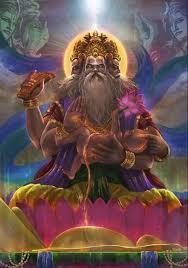Brahma is said to have created the entire universe, including himself. He began by creating water and dropping a seed into the primal ocean. The seed became a golden egg from which Brahma emerged. The remaining shell and material of the golden egg then expanded to become the universe. Brahma is the Hindu god of creation. Also known as the grandfather, he was the original creator of the universe. Due to his elevated rank, Brahma rarely appears in the picturesque myths in which gods take on human form and character. Rather, he is generally presented more abstractly as the ideal of a great god. His four heads represent the four Vedas and are pointed to the four cardinal directions. He is seated on a lotus and his vahana (mount) is a hamsa (swan, goose or crane). According to the scriptures, Brahma created his children from his mind and thus, they are referred to as Manasaputra. Brahma is the Hindu creator god. He is also known as the Grandfather and as a later equivalent of Prajapati, the primeval first god. In early Hindu sources such as the Mahabharata, Brahma is supreme in the triad of great Hindu gods which includes Shiva and Vishnu. Three of the most significant forms of Brahman are Brahma , Shiva and Vishnu . These three gods are key aspects of Brahman, the Ultimate Reality . The word ‘trimurti’ means ‘three forms’. Vishnu is known as “The Preserver” within the Trimurti, the triple deity of supreme divinity that includes Brahma and Shiva. In Vaishnavism, Vishnu is the supreme being who creates, protects, and transforms the universe. According to the Bhagavata Purana, some of the manasaputras are: Angiras (sage), Atri, Pulastya, Marichi, Pulaha, Jambavan, Bhrigu, Vashistha, Daksha, Narada, Chitragupta, the Four Kumaras, Himavat, and Shatarupa.
In the beginning, Brahma sprang from the cosmic golden egg and he then created good & evil and light & dark from his own person. He also created the four types: gods, demons, ancestors, and men (the first being Manu). Brahma then made all living creatures upon the earth (although in some myths Brahma’s son Daksa is responsible for this). In the process of creating, perhaps in a moment of distraction, the demons were born from Brahma’s thigh and so he abandoned his own body which then became Night. After Brahma created good gods he abandoned his body once again, which then became Day, hence demons gain the ascendancy at night and gods, the forces of goodness, rule the day. Brahma then created ancestors and men, each time again abandoning his body so that they became Dusk and Dawn respectively. This process of creation repeats itself in every aeon. Brahma then appointed Shiva to rule over humanity although in later myths Brahma becomes a servant of Shiva.
Brahma is the Hindu creator god. He is also known as the Grandfather and as a later equivalent of Prajapati, the primeval first god. In early Hindu sources such as the Mahabharata, Brahma is supreme in the triad of great Hindu gods which includes Shiva and Vishnu. Brahma, due to his elevated status, is less involved in picturesque myths where gods take on human form and character but is rather a generally abstract or metaphysical ideal of a great god. In later Puranas (Hindu epics) Brahma is no longer worshipped and other gods are assigned his myths, even if he always maintains his status as the creator god. Brahma’s epithet is ekahamsa, the One Swan. His vahanam (‘vehicle’) is a peacock, swan or goose. He is still honoured today with an annual ceremony at the pilgrimage site of Pushkar in Rajasthan, India and he remains a popular figure in Southeast Asia, especially in Thailand and Bali.
